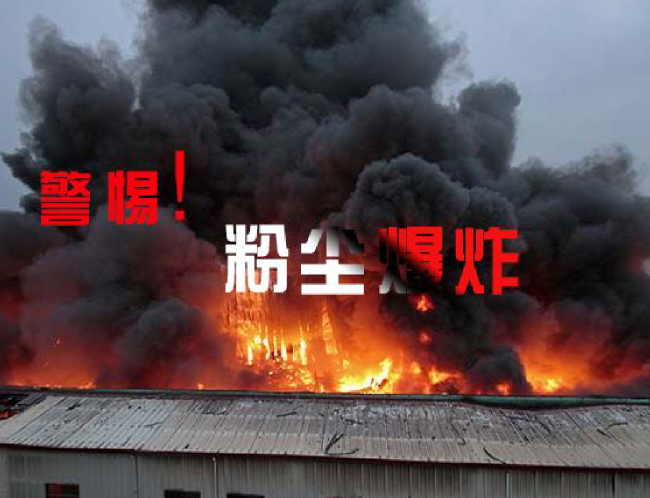
Dust explosion
Combustible dust within the explosive limit range, when encountering a heat source (open flame or high temperature), the flame instantly spreads to the entire mixed dust space; The chemical reaction rate is extremely fast, while releasing a large amount of heat, forming high temperature and high pressure. The energy of the system is converted into mechanical energy and radiation of light and heat, which is extremely destructive.
Dust explosions often occur in production and processing sites accompanied by aluminum powder, zinc powder, aluminum processing and grinding powder, various plastic powders, intermediates of organic synthetic drugs, wheat flour, sugar, sawdust, dyes, bakelite ash, milk powder, tea powder, tobacco powder, coal dust, plant fiber dust, etc.
The hazards of dust explosions
1. Has extremely strong destructive power. Dust explosions involve a wide range of areas, including coal, chemical, pharmaceutical processing, wood processing, grain and feed processing, etc.
2. Easy to cause secondary explosions. A blast wave raises the dust deposited on the equipment or ground, and in a short period of time after the explosion, a negative pressure will be formed in the central area of the explosion. The surrounding fresh air will be filled in from the outside to the inside, mixed with the raised dust, and ignited by the afterfire of the first explosion, causing a second explosion. During a secondary explosion, the dust concentration is generally much higher than during a primary explosion, so the power of a secondary explosion is much greater than that of a primary explosion.
3. Produce toxic gases. One is carbon monoxide; Another type is the toxic gas generated by the decomposition of explosives (such as plastic) themselves. The production of toxic gases often leads to poisoning and casualties in humans and animals after explosions, and must be given full attention.

The conditions for generating dust explosions
1. Dust itself has combustibility, and combustible dust refers to dust that undergoes violent oxidation reactions with gaseous oxidants (mainly air) under certain conditions.
2. In a limited space, dust is suspended in the air and reaches an explosive concentration (the lowest concentration of the explosion is called the lower explosive limit, and the highest concentration is the upper explosive limit. Due to the large upper explosive limit value of dust, it cannot be reached in most situations, so it is rarely used).
3. The initial energy sufficient to cause dust explosion can manifest in various forms such as flames, electric sparks, etc.
Dust explosion parameters
Dust explosiveness parameters are important basis for conducting explosion hazard assessment and explosion protection, and these parameters are related to the composition, particle size distribution, and humidity of dust. Mainly including:
1. Maximum explosion pressure Pmax: The maximum value of all explosion pressure peaks corresponding to different concentration values within the range of combustible dust concentration in the dust cloud under the specified volume and ignition energy.
2. Explosion index Kst: In a closed container, the product of the maximum rate of explosion pressure rise in a dust explosion test and the cube root of the container volume is a constant, which is called the explosion index of dust. The dust explosion index is expressed as Kst value, in MPa · m/s.
3. Lower explosive limit (LEL): refers to the minimum concentration at which a mixture of combustible vapor, gas, or dust and air can explode upon contact with a fire source (the concentration of combustible vapor, gas, calculated by volume ratio)
4. Minimum ignition energy (MIE): The minimum value of the ignition source energy that ignites a dust cloud under the most easily ignitable concentration conditions;
5. Minimum ignition temperature of dust layer MIT-L: The minimum hot surface temperature at which a certain thickness of dust layer on a specific hot surface can ignite under atmospheric pressure and room temperature conditions.
6. Limiting oxygen concentration (LOC): It is a characteristic indicator used to evaluate and classify the flammability of liquid or solid materials. It is suitable for evaluating the flammability or flame retardancy of materials such as plastics, rubber, resins, fabrics, wood, insulating liquids, etc.
7. Maximum explosion pressure Pmax: The maximum value of the peak explosion pressure corresponding to different concentrations of dust clouds at a specified volume and ignition energy, measured experimentally, in MPa;
The maximum rate of increase in explosion pressure and the explosion index Kst are important parameters reflecting the intensity of explosion, used for explosion pressure relief, explosion suppression, explosion isolation, and anti explosion design.